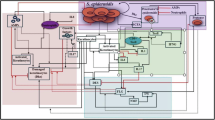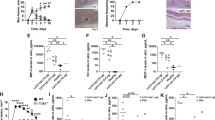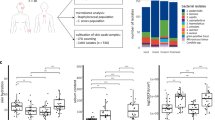Abstract
The normal microflora of the skin includes staphylococcal species that will induce inflammation when present below the dermis but are tolerated on the epidermal surface without initiating inflammation. Here we reveal a previously unknown mechanism by which a product of staphylococci inhibits skin inflammation. This inhibition is mediated by staphylococcal lipoteichoic acid (LTA) and acts selectively on keratinocytes triggered through Toll-like receptor 3(TLR3). We show that TLR3 activation is required for normal inflammation after injury and that keratinocytes require TLR3 to respond to RNA from damaged cells with the release of inflammatory cytokines. Staphylococcal LTA inhibits both inflammatory cytokine release from keratinocytes and inflammation triggered by injury through a TLR2-dependent mechanism. To our knowledge, these findings show for the first time that the skin epithelium requires TLR3 for normal inflammation after wounding and that the microflora can modulate specific cutaneous inflammatory responses.
This is a preview of subscription content, access via your institution
Access options
Subscribe to this journal
Receive 12 print issues and online access
$259.00 per year
only $21.58 per issue
Buy this article
- Purchase on SpringerLink
- Instant access to full article PDF
Prices may be subject to local taxes which are calculated during checkout





Similar content being viewed by others
References
Rakoff-Nahoum, S., Paglino, J., Eslami-Varzaneh, F., Edberg, S. & Medzhitov, R. Recognition of commensal microflora by Toll-like receptors is required for intestinal homeostasis. Cell 118, 229–241 (2004).
Xu, J. et al. A genomic view of the human-Bacteroides thetaiotaomicron symbiosis. Science 299, 2074–2076 (2003).
Rakoff-Nahoum, S., Hao, L. & Medzhitov, R. Role of Toll-like receptors in spontaneous commensal-dependent colitis. Immunity 25, 319–329 (2006).
Netea, M.G., Van der Meer, J.W. & Kullberg, B.J. Toll-like receptors as an escape mechanism from the host defense. Trends Microbiol. 12, 484–488 (2004).
Kelly, D., Conway, S. & Aminov, R. Commensal gut bacteria: mechanisms of immune modulation. Trends Immunol. 26, 326–333 (2005).
Steidler, L. et al. Treatment of murine colitis by Lactococcus lactis secreting interleukin-10. Science 289, 1352–1355 (2000).
Vandenbroucke, K. et al. Active delivery of trefoil factors by genetically modified Lactococcus lactis prevents and heals acute colitis in mice. Gastroenterology 127, 502–513 (2004).
Haller, D. et al. Transforming growth factor-β1 inhibits nonpathogenic Gram negative bacteria–induced NF-κB recruitment to the interleukin-6 gene promoter in intestinal epithelial cells through modulation of histone acetylation. J. Biol. Chem. 278, 23851–23860 (2003).
Marshak-Rothstein, A. & Rifkin, I.R. Immunologically active autoantigens: the role of Toll-like receptors in the development of chronic inflammatory disease. Annu. Rev. Immunol. 25, 419–441 (2007).
Leadbetter, E.A. et al. Chromatin-IgG complexes activate B cells by dual engagement of IgM and Toll-like receptors. Nature 416, 603–607 (2002).
Matzinger, P. Tolerance, danger and the extended family. Annu. Rev. Immunol. 12, 991–1045 (1994).
Marshak-Rothstein, A. Toll-like receptors in systemic autoimmune disease. Nat. Rev. Immunol. 6, 823–835 (2006).
Ziebuhr, W. et al. Nosocomial infections by Staphylococcus epidermidis: how a commensal bacterium turns into a pathogen. Int. J. Antimicrob. Agents 28 Suppl 1, S14–S20 (2006).
Bibel, D.J. et al. Competitive adherence as a mechanism of bacterial interference. Can. J. Microbiol. 29, 700–703 (1983).
Lebre, M.C. et al. Human keratinocytes express functional Toll-like receptor 3, 4, 5, and 9. J. Invest. Dermatol. 127, 331–341 (2007).
Pivarcsi, A. et al. Expression and function of Toll-like receptors 2 and 4 in human keratinocytes. Int. Immunol. 15, 721–730 (2003).
Baker, B.S., Ovigne, J.M., Powles, A.V., Corcoran, S. & Fry, L. Normal keratinocytes express Toll-like receptors (TLRs) 1, 2 and 5: modulation of TLR expression in chronic plaque psoriasis. Br. J. Dermatol. 148, 670–679 (2003).
Alexopoulou, L., Holt, A.C., Medzhitov, R. & Flavell, R.A. Recognition of double-stranded RNA and activation of NF-κB by Toll-like receptor 3. Nature 413, 732–738 (2001).
Fujimoto, C., Nakagawa, Y., Ohara, K. & Takahashi, H. Polyriboinosinic polyribocytidylic acid [poly(I:C)]/TLR3 signaling allows class I processing of exogenous protein and induction of HIV-specific CD8+ cytotoxic T lymphocytes. Int. Immunol. 16, 55–63 (2004).
Cavassani, K.A. et al. TLR3 is an endogenous sensor of tissue necrosis during acute inflammatory events. J. Exp. Med. 205, 2609–2621 (2008).
Brown, D.L., Kao, W.W. & Greenhalgh, D.G. Apoptosis down-regulates inflammation under the advancing epithelial wound edge: delayed patterns in diabetes and improvement with topical growth factors. Surgery 121, 372–380 (1997).
Kono, H. & Rock, K.L. How dying cells alert the immune system to danger. Nat. Rev. Immunol. 8, 279–289 (2008).
Vanhoutte, F. et al. Toll-like receptor (TLR)2 and TLR3 synergy and cross-inhibition in murine myeloid dendritic cells. Immunol. Lett. 116, 86–94 (2008).
Ghosh, T.K. et al. TLR-TLR cross talk in human PBMC resulting in synergistic and antagonistic regulation of type-1 and 2 interferons, IL-12 and TNF-α. Int. Immunopharmacol. 7, 1111–1121 (2007).
Lambert, P.A., Worthington, T., Tebbs, S.E. & Elliott, T.S. Lipid S, a novel Staphylococcus epidermidis exocellular antigen with potential for the serodiagnosis of infections. FEMS Immunol. Med. Microbiol. 29, 195–202 (2000).
Weidenmaier, C. et al. Role of teichoic acids in Staphylococcus aureus nasal colonization, a major risk factor in nosocomial infections. Nat. Med. 10, 243–245 (2004).
Kawai, T. & Akira, S. TLR signaling. Semin. Immunol. 19, 24–32 (2007).
Hooper, L.V. Do symbiotic bacteria subvert host immunity? Nat. Rev. Microbiol. 7, 367–374 (2009).
Timmerman, C.P. et al. Induction of release of tumor necrosis factor from human monocytes by staphylococci and staphylococcal peptidoglycans. Infect. Immun. 61, 4167–4172 (1993).
Yoshioka, M. et al. Lipoteichoic acid downregulates FcεRI expression on human mast cells through Toll-like receptor 2. J. Allergy Clin. Immunol. 120, 452–461 (2007).
Han, J. & Ulevitch, R.J. Limiting inflammatory responses during activation of innate immunity. Nat. Immunol. 6, 1198–1205 (2005).
Stack, J. et al. Vaccinia virus protein A46R targets multiple Toll-like-interleukin-1 receptor adaptors and contributes to virulence. J. Exp. Med. 201, 1007–1018 (2005).
Harte, M.T. et al. The poxvirus protein A52R targets Toll-like receptor signaling complexes to suppress host defense. J. Exp. Med. 197, 343–351 (2003).
Thompson, A.J. & Locarnini, S.A. Toll-like receptors, RIG-I–like RNA helicases and the antiviral innate immune response. Immunol. Cell Biol. 85, 435–445 (2007).
Szpaderska, A.M. & DiPietro, L.A. Inflammation in surgical wound healing: friend or foe? Surgery 137, 571–573 (2005).
Wetzler, C., Kampfer, H., Stallmeyer, B., Pfeilschifter, J. & Frank, S. Large and sustained induction of chemokines during impaired wound healing in the genetically diabetic mouse: prolonged persistence of neutrophils and macrophages during the late phase of repair. J. Invest. Dermatol. 115, 245–253 (2000).
Gründling, A. & Schneewind, O. Synthesis of glycerol phosphate lipoteichoic acid in Staphylococcus aureus. Proc. Natl. Acad. Sci. USA 104, 8478–8483 (2007).
Schauber, J. et al. Histone acetylation in keratinocytes enables control of the expression of cathelicidin and CD14 by 1,25-dihydroxyvitamin D3 . J. Invest. Dermatol. 128, 816–824 (2007).
Nizet, V. et al. Innate antimicrobial peptide protects the skin from invasive bacterial infection. Nature 414, 454–457 (2001).
Acknowledgements
We thank A. Peschel for advice regarding blocking LTA activity by the antibody; E. Raz from the University of California–San Diego for providing a C57BL/6 Tlr3-deficient mouse breeding pair; V. Nizet and E. Tistiskov for helpful discussion; G. Cheng, B. Beutler, R. Modlin and E. Raz for critical reading and helpful advice; and D. Bird for histological sections. This work was supported by US National Institutes of Health grants R56AI083358, R01AR052728 and R01 AI052453 and a US Veterans Administration Merit Award to R.L.G. and US National Institutes of Health grants DC00129 and DC006279 to A.F.R.
Author information
Authors and Affiliations
Contributions
Y.L. and R.L.G. designed the experiments; Y.L. performed most of the experiments and analyzed data; A.D.N. helped in culture of bone-marrow-derived dendritic cells and preparation of UVB-irradiated apoptotic and necrotic cells; T.N. and A.L. helped with mouse experiments; Y.Y. and Z.-R.W. designed the LPS-induced inflammation model; A.L.C. helped to perform initial experiments; L.V.H. provided germ-free mouse ear and intestine samples; R.R.S. and S.v.A. provided synthetic LTAs; K.A.R. showed how to make mouse wound models; C.-M.H. helped to modify the protocol for animal study; A.F.R. provided Tlr2-deficient mice; Y. L. and R.L.G. wrote and prepared the manuscript.
Corresponding author
Supplementary information
Supplementary Text and Figures
Supplementary Figures 1–8 and Supplementary Methods (PDF 2685 kb)
Rights and permissions
About this article
Cite this article
Lai, Y., Di Nardo, A., Nakatsuji, T. et al. Commensal bacteria regulate Toll-like receptor 3–dependent inflammation after skin injury. Nat Med 15, 1377–1382 (2009). https://doi.org/10.1038/nm.2062
Received:
Accepted:
Published:
Issue date:
DOI: https://doi.org/10.1038/nm.2062
This article is cited by
-
Reactive metal boride nanoparticles trap lipopolysaccharide and peptidoglycan for bacteria-infected wound healing
Nature Communications (2022)
-
The Priming Potential of Interferon Lambda-1 for Antiviral Defense in the Oral Mucosa
Inflammation (2022)
-
IL-36 receptor antagonist deficiency resulted in delayed wound healing due to excessive recruitment of immune cells
Scientific Reports (2020)
-
Skin Microbiota and its Interplay with Wound Healing
American Journal of Clinical Dermatology (2020)



